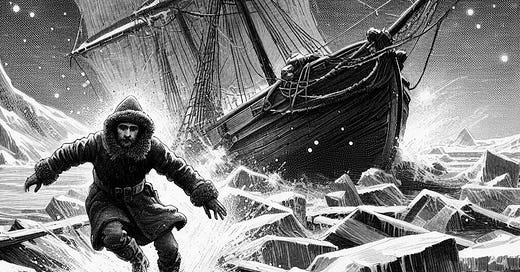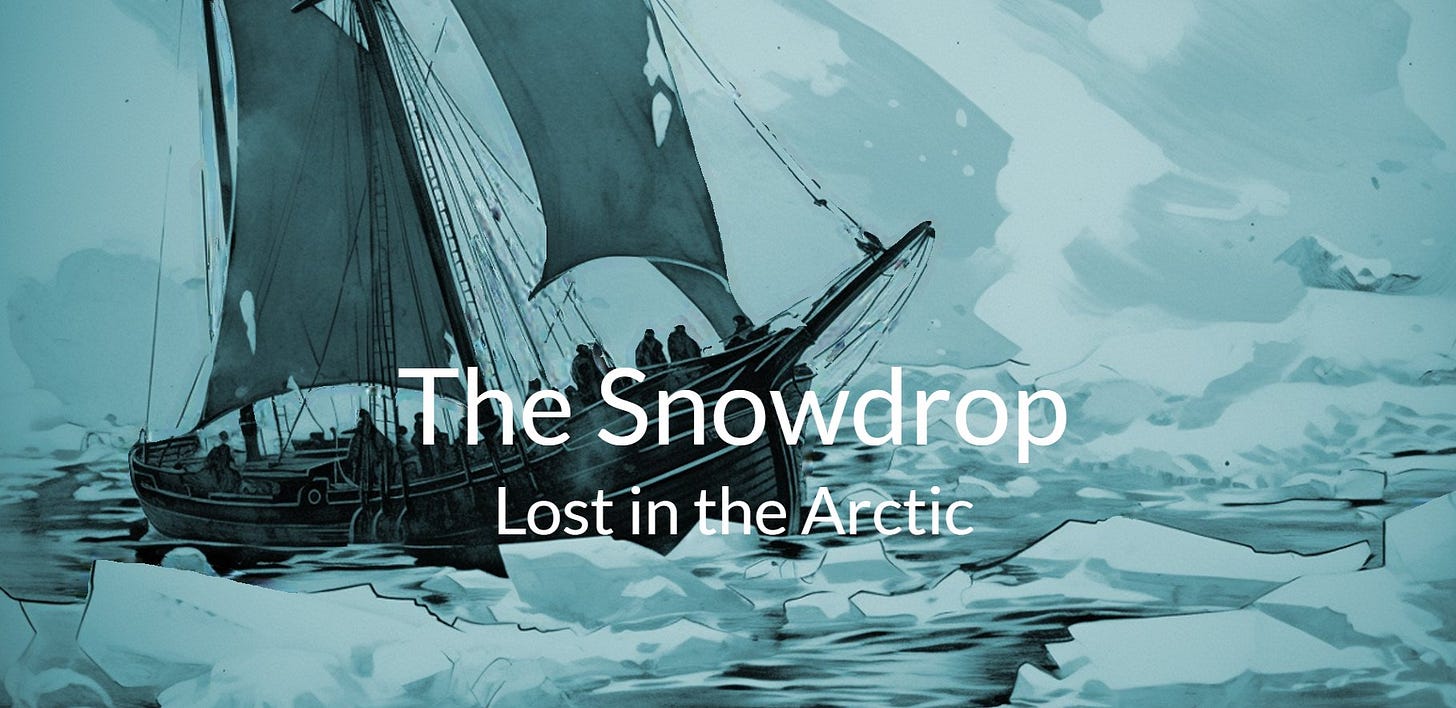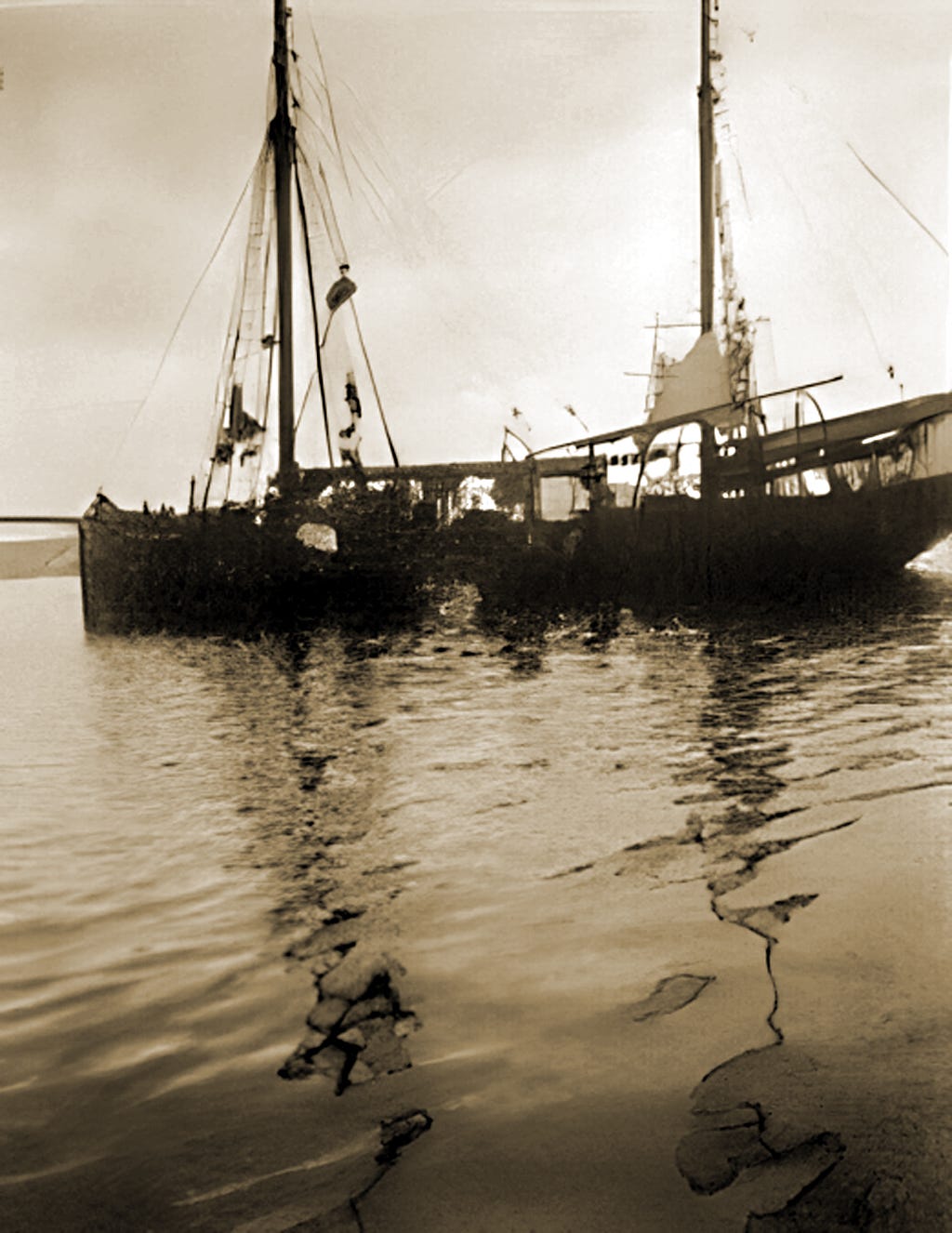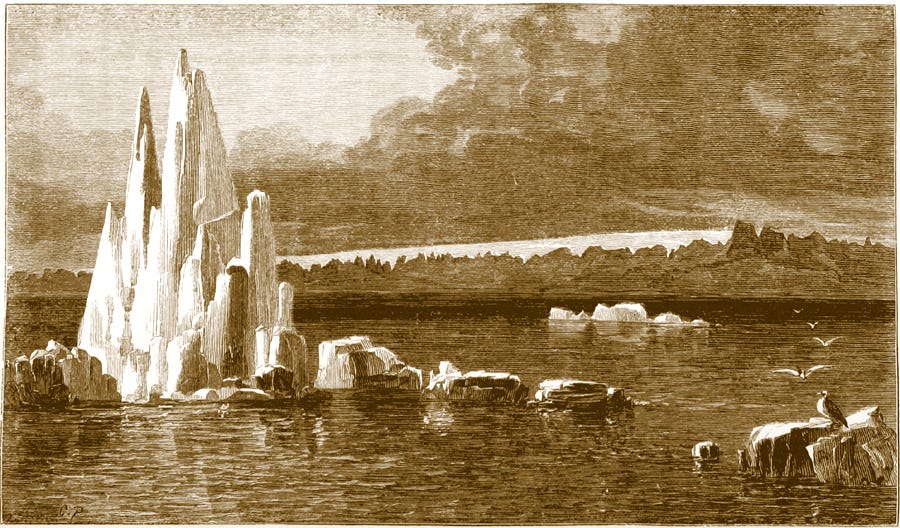The Snowdrop: Bonus Content
More on the remarkable story of the Scottish whaler that was lost in the Arctic
Last week, I published my latest non-fiction longread article, The Snowdrop: Lost in the Arctic. It’s the story of a Scottish whaling ship that was wrecked in the Arctic, and a young seaman who set off on a hundreds-of-miles journey to find help. If you’ve not already read it, you can find it here:
The Snowdrop: Lost in the Arctic
There were lots of interesting bits and pieces that I couldn’t fit into the article, so here is some bonus content — the DVD extras of The Snowdrop:
Bonus Content:
The Storage Tank Rescue
Even before the journey began, the Snowdrop was the scene of an almost-fatal accident. Two men were overcome with charcoal smoke during the fumigation of the storage tanks. George Marnie and John Livie collapsed and passed out inside one of the tanks. According to a newspaper report, the ship’s mate, Jimmy Steele, “pluckily effected a rescue,” climbing into the tank and dragging the pair out using ropes. Two policemen administered mouth-to-mouth resuscitation, and Marnie and Livie were taken in an ambulance to the Infirmary. Both survived, and Marnie rejoined the crew before departure—although he deserted when the Snowdrop reached Aberdeen.
The Engine Would Not Work
Captain Brown’s logbook records times, bearings, and weather conditions, with only brief snippets of other information. One recurring subject is the Snowdrop’s engine. “The engine would not work,” Brown writes on day one of his log. “Engine still unworkable,” reads another entry. “Finished repairing the engine,” reads another. A few days later, again: “The engine would not work.” And later, in the Arctic water: “Engine broke down for an hour. Sent a boat ahead to tow.” So, although the Snowdrop had a rare advantage as a small whaler with an engine, that engine was anything but reliable.
Cape Haven
The site of the OC Forsyth-Grant’s trading station and the attendant Inuit settlement was Cape Haven (known to the Inuit as Singaijaq) on the Hall Peninsula of Baffin Island (Qikiqtaaluk) in Canada (now part of the Nunavut territory). Alex Richie, in his written account, calls it Signia. Captain Brown, in his logs, calls it Signaia. Modern mapping, including Google Maps, shows Cape Haven. I refer to the site as Cape Haven in the text, rather than using the Inuit name, in an attempt to avoid confusion.
The NWT Archives holds a set of photos taken by RC Elliott in 1973 showing the remains of the whaling station at Cape Haven. These remains probably postdate the Forsyth-Grant station. After Forsyth-Grant’s death, the station was purchased by the Scottish Sabellum Company.
Mitsiga
OC Forsyth-Grant was well-known among the Baffin Island Inuit and left a legacy in their community. According to oral accounts recorded in the book When the Whalers Were Up North by Dorothy Harley Eber, stories of the man they call Mitsiga still circulate. Forsyth-Grant lived in a Cape Haven cabin with the Inuit community’s chief trader, Gotilliaktuk, and his wife, Nangiaruk. According to an account collected by Eber, one trade, according to the custom of the time, involved the loan of Gotilliaktuk’s wife.
“In those days,” said Eber’s informant, “even though a woman was married she might be borrowed by somebody else. Mitsiga and Nangiaruk had children—they are dead today, but there are descendants.”
Mary Ipeelie, the great-granddaughter of Gotilliaktuk and Nangiaruk, said she remembered seeing framed photographs of Mitsiga and Nangiaruk together. Mary’s grandfather was Ainiak, the son of Gotilliaktuk and Nangiaruk, and she said he traveled to Scotland in 1907 with Forsyth-Grant. That would mean Ainiak was the teenager known to the Scots as Inear. According to Mary, Forsyth-Grant was fond of Ainiak because he was “the son of his woman” and effectively his stepson.
The Hunt
Captain Brown’s logbook records the day-to-day efforts of the Snowdrop’s hunting expedition before the wreck. Each day, expeditions set off to search for walruses, seals, reindeer, polar bears, arctic fox, salmon, cod, and—fruitlessly on this voyage—whales.
“8.30. Lowered the boats for walrus… 7 pm. The boats returned having got twenty-six walrus, two of which were cut up for foregoers [used to attach the harpoons to the whale lines].”
“All the natives and Mr [Forsyth-] Grant went away deer hunting at 4 am… The last of the hunters returned having got twelve reindeer.”
“Saw a whale today, apparently scared.”
Brown’s log records that the Snowdrop caught six hundred and fifty-one walrus and six hundred seals, plus ninety reindeer, ninety-nine bears, ninety fox, ninety-eight salmon, and one hundred and one cod, but no whales.
One of the reasons the Snowdrop never caught a whale during its truncated voyage was that commercial whaling during the 19th century had caused a severe decline in whale numbers. Commercial whaling had peaked during the mid-1800s — around the time that Herman Melville published his 1851 novel Moby Dick.
The Death of Eaping
On September 11, 1908, a week before the wreck, the Inuit’s “head native,” Eaping, died on board the Snowdrop. According to Captain Brown: “He had been ailing for some time with an internal complaint.” Eaping was taken to shore and buried. Brown’s log, generally impersonal, gives an indication of his longstanding relationship with the Inuit: “I read the Church of England service on the good old man I have known for these last 42 years.”
Come and Get a Feed
According to Alex Ritchie, before they started hunting, the crew of the Snowdrop had put more than seven tons of store ashore at Cape Haven. But when they returned after the wreck, Forsyth-Grant refused to share the store. Perhaps he was protecting the supplies in anticipation of a long winter, but Ritchie saw the move as antagonistic. “Well, when we got there, our owner [Forsyth-Grant] would not give us anything,” said Ritchie, “so we had to depend on what the Eskimo could give us for food. It was very hard to get used to eating raw seal flesh.”
By contrast, the Inuit were happy to share. “If they got a seal, we would get a share from them. When an Eskimo man gets a seal, he brings it home and takes off the portion they’re going to eat and goes to the door of his tent or snow house, and he shouts to the whole community, ‘Inuit, kyeat uong.’ That's ‘Everybody, come and get a feed,’ in our language. We were always hungry but always got what our Eskimo friends could give us.”
The Yaka Polka
Ritchie lived with the Inuit and enjoyed their company and customs, particularly their feasts when an Inuit who caught a seal would invite everyone to come and eat, sing, and dance. Ritchie was surprised to hear the Inuit sing hymns that he recognized by the tunes, if not the words. But his favorite Inuit song was a jolly foot-tapper he called the Yaka Polka. “These Eskimo people are very fine-natured,” he said. “They always kept some food for me, although they were hungry themselves. I found them very pleasant to be with.”
Had a Baby
From Captain Brown’s log, October 16, 1908: “A native woman had a baby this morning. The whole thing was over and her at work within two hours.”
Ten days later, a woman named by Brown as “Cackmatan’s wife” also had a baby. According to Brown’s records, the community now included thirteen children living in extremely difficult conditions with dwindling food. At one point, Brown wrote that the community was “obliged to eat seaweed.”
Sharing the Biscuits
Ritchie and four of his crewmates eventually left Cape Haven with five Inuit families in an effort to reach Hudson Bay. Before Ritchie left, OC Forsyth-Grant came to him and asked him to stay. The sleds were already packed, and the dogs were already harnessed. Forsyth-Grant gave Ritchie a bag of biscuits, some butter, tea, coffee, sugar, and fifty rifle cartridges, saying that would be enough as he would “soon get fed up.” “I told him I would not come back,” said Ritchie.
After their first night of travel, when the Inuit had made their snow house, Ritchie called them all together and shared the biscuits and coffee and tea. “Not a morsel was left. There was no use keeping a few biscuits, as I was to depend on the Eskimo, and live as he lived.”
“I remember our engineer, Jimmy Smith was his name. He said to me, ‘You know you shouldn’t have given away all the biscuits. You should have kept some.’ I said, ‘What for?’ He said, ‘We would have had a biscuit now and again, man.’ I said, ‘Jimmy, we have to stay with these Eskimo people and we have to be dependent on them.’ And I says, ‘If they saw us eating a biscuit, not offering them, what would they think?’ He says, ‘That’s true enough.’”
The Polar Bears
After his companions turned back, Ritchie pressed on toward Hudson Bay with a new Inuit family—Sho, his wife Neevie, and their two-year-old son. Traveling with them were another man and wife named Eperbeg and Cumanow. “They were grand hunters,” said Ritchie. One story in particular highlighted the brutal hunting practices required to survive in the Arctic:
The party came across five polar bears – a male, a female, and three cubs. The Inuit shot the two adult bears, but the male fell into a steep crevasse, and the Inuit would not eat the female—nor let their dogs eat her—as she was full of milk. They skinned the female and left both carcasses on the ice. “They brought the skin of the mother bear to the house, killed two of the cubs for food, and kept one,” said Ritchie. “It traveled with us all the time until we arrived in Hudson Bay.”
Rubbing Noses
When Ritchie was struggling on the vast expanse of the Grinnell Glacier, the Inuit told him that “if I could manage to stick it out,” he would be the first white man to cross the glacier. “I never fell behind again,” he said. “I always managed to keep up with them and did not hinder them in any way.”
After four days on the glacier, Ritchie and his friends reached the coast and crossed in boats to the Inuit home village on Saddleback Island. “My people told their friends who I was, and I shook hands with them all. I think I was a bit of a curiosity as young and old came to see me. My friends, the Eskimo, did not shake hands with the other Eskimos; they all rubbed noses.”
The Inuit Kings
When Ritchie arrived in Kimmirut, he was taken to see the community leader, King Agai, and was given treacle in boiling water. “I thought I never tasted anything so nice in all my life,” he said. But Ritchie was very ill. He fell into a coma and was unconscious for twenty-one days.
When he awoke, the Inuit took Ritchie back to Saddleback Island, where the Dundee whaler Active could be found. Ritchie traveled with King Watchi, the son of King Agai. Watchi had worked with the Active, and had travelled to Dundee with the ship in the previous year.
Are You a White Man?
When Ritchie reached the Active, he was amazed to see three men he had sailed with on a previous voyage. None of them recognized him. One of the men was Jimmy Scott. “Jimmy,” said Ritchie, “don’t you know me?” Scott bounded for the cabin and brought out the captain, Alex Murray, saying, “There is one of the Snowdrop’s crew aboard!” The Captain was puzzled. “Are you a white man?” he asked. “Yes,” said Ritchie.
Later, when Ritchie boarded the Lorna Doone, he met a missionary named Ernest Peck, who had been living among the Inuit for 32 years. Now Ritchie understood how the Inuit sang the hymns he recognized—albeit in their own languages. The ship was heading for Newfoundland, and Ritchie asked Peck if he could go with them. “And he turned and he looked at me and said he thought I was an Eskimo. Oh, no, I said. I’m a Scotchman!”
Peary vs Cook
Captain Brown, OC Forsyth-Grant, and the rest of the crew were rescued by the Jeanie, an Arctic exploration vessel that was the store ship for the Robert Peary North Pole expedition, carrying an American hunter and explorer named Harry Whitney. The return of Whitney on the Jeanie was much anticipated because it was believed that he could reveal which of two competing expeditions had been first to reach the North Pole.
Whitney had traveled to the Arctic with Robert Peary and previously with Frederick Cook. Peary claimed to have reached the North Pole on April 6, 1909, but Cook claimed he had reached the Pole a year earlier, on April 21, 1908. Cook left his navigation records with Whitney, but Peary refused to have them on board, and the records were lost. Neither Cook nor Peary could present indisputable evidence that they were the first man to reach the North Pole.
And so the crew of the Snowdrop was caught up in the North Pole row. Whitney claimed he was unable to go back to fetch Cook’s records because he no longer had any of his forty guns—he had gifted one to each member of the Jeanie’s crew and sold the remainder plus ammunition to OC Forsyth-Grant.
Whitney said he believed Cook had been the first to reach the Pole, but Cook’s claim was never widely accepted. Peary’s claim, although initially accepted, has since been discredited. The first documented expedition to reach the North Pole was by Roald Amundsen and fifteen other men, who reached the Pole by airship in 1926. (The first man to reach the Pole by foot was British adventurer Wally Herbert in 1969.)
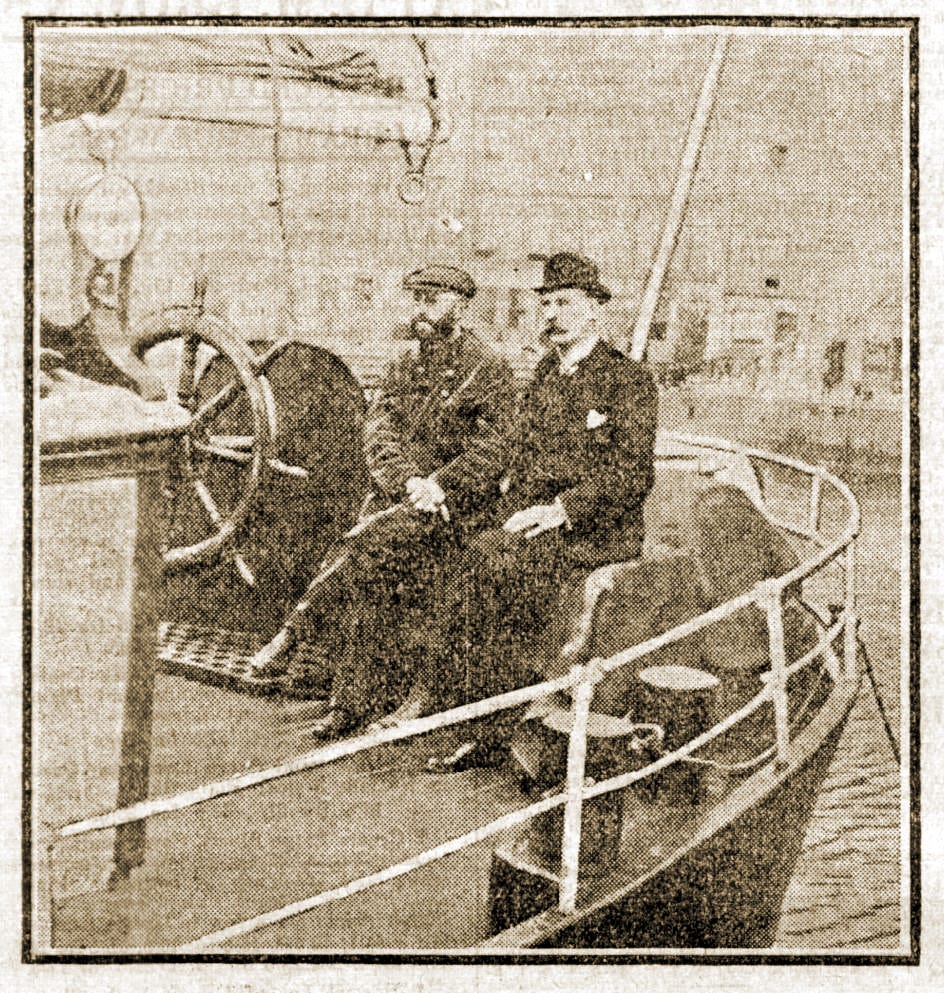
Poor Morrison
When the Snowdrop crew returned home without John Morrison, Forsyth-Grant said that when he last saw him, although he was too ill to be moved, he was recovering. Forsyth-Grant said he had given him matches, tobacco, soap, skins, and meat before leaving him in the care of the Inuit. “We certainly gave him plenty of stuff to eat, and he ought to be alright.”
After the Jeanie arrived to rescue the crew, Forsyth-Grant took a launch along the coast to try to find Morrison, but it was thought he had been moved inshore. Forsyth-Grant said there was no doubt that, with the assistance of the Inuits, he would survive and return home. Unfortunately, that was not the case.
“To his parents in Aberdeen, the news of Morrison’s death will be a heavy blow,” said the Dundee Courier. “During the two years that have elapsed since he was last seen by a white man, his parents clung to hope that he would yet be returned to them, but it appears that he expired after undergoing a second operation for frostbite.”
Reverend Greenshield
The Reverend Edgar William Tyler Greenshield, who brought news of the fate of John Morrison, was born on the Isle of Wight in 1877. Having trained as a missionary, he first visited the Baffin Island Inuits in 1901 as an assistant to the Reverend Ernest Peck (who Alex Ritchie met during his rescue attempt).
Greenshield made ten voyages to the Arctic. The Inuit called him Ilataaqauq. After surviving the wreck of the Dutch schooner Jantina Agatha (while searching for the Snowdrop), Greenshield was awarded the Knight of the Order of Orange Nassau for his courage by the Queen of the Netherlands.
In 1932, Archibald Lang Fleming (the so-called Bishop of the Arctic) published a book titled Perils of the Polar Pack or The Adventures of the Reverend EWT Greenshield. The British Museum has a remarkable collection of photographs taken by Reverend Greenshield on Baffin Island and elsewhere in the Artic between 1901 and 1913.
Lost Among the Snow
Writing to a Dundee newspaper following the loss of the Snowdrop, trawlermaster George Clarke noted the synchronicity of her name. “There are some rather peculiar coincidences about her,” he wrote. “Her keel was laid in a snowstorm. I saw her launched, and it was snowing fit to blind you. I saw her go on her first trip, and it was snowing so hard that one could scarcely see the tug in front of her. She was christened the Snowdrop, and she has been lost among the snow.” ◆
Finally, I mentioned in the story that Alex Ritchie told his story to BBC radio in the 1950s. The Maggie Law Maritime Museum has published a recording of the story on Soundcloud:
Here’s another link to the full story: The Snowdrop: Lost In The Arctic.
And here’s a reminder that my book The Tyne Bridge is out now in paperback. It’s available now from Amazon* or your favourite bookseller.
You can also get it from Hurst Publishers. And if you’re quick, you can get 25% off using the code TYNE25.
You can find more info about the book at tynebridgebook.com.
Thanks for reading. More Singular Discoveries next month. Please share and subscribe!


